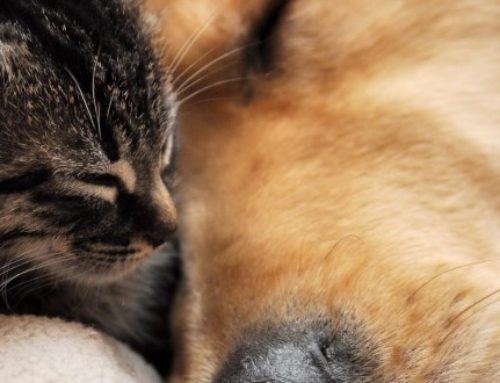There are a wide range of different causes of heart disease in dogs and cats – in particular, we think of hypertrophic cardiomyopathy in cats, dilated cardiomyopathy in dogs, “leaky valves” (endocardiosis), valve stenosis, arrhythmias, and many more. However, whatever the underlying condition, they all lead to the same place in the end – congestive heart failure, or CHF.
Whatever the underlying cause, a failing heart results in a gradual reduction in systemic blood pressure. This reduction is detected by the kidneys, which respond by activating as system called RAAS (Renin, Angiotensin Aldosterone System).
The kidneys trigger it by releasing a chemical called renin. Renin acts on proteins in the blood to convert Angiotensinogen to Angiotensin I; which is then converted by an enzyme in the lungs (called Angiotensin Converting Enzyme, or ACE) into the active form, Angiotensin II.
Angiotensin II has a range of effects on the body; but primarily it drives the retention of fluid – more salt is retained by the kidney, so more water is retained in the blood vessels. In the short term, this increases blood pressure, which is the reason the system is activated.
The RAAS is very well adapted by evolution to help an animal survive serious injury – typically, severe blood loss. In this situation, the problem is that the blood volume is too low, so boosting it is exactly the right response, allowing the blood pressure to be maintained while the body heals itself. However, in heart failure, the blood volume is normal, the problem is that the heart is pumping too weakly. Retaining fluid when the pump isn’t working properly doesn’t help – in fact, it makes it worse because the pump then has to work even harder to move the extra blood volume.
The harder the heart has to work, the sooner it will fail, so this RAAS activation actually makes matters worse. In addition, it is responsible for most of the symptoms of heart failure.
The increased fluid volume means that the blood vessels, especially the veins, are over- full; ultimately, this leads to leakage of fluid into other parts of the body. We commonly see ascites, or fluid on the abdomen, as fluid builds up in the belly. This is why so many cats and dogs in heart failure have a pot-bellied appearance. The over full veins also explain the distended and pulsing jugular veins that are quite common. However, the worst effect is that fluid tends to leak out of the small vessels in the lungs, leading to pulmonary oedema (fluid on the lungs). The extra fluid here makes it harder and harder to breathe, resulting in coughing (although this is also partly due to pressure on
the windpipe from an enlarged heart), increased breathing rate and difficulty catching breath. Ultimately, this is usually the cause of death for animals in heart failure – internal drowning as the fluid builds up to the point where they cannot get enough oxygen into their blood.
So, what can we do about this?
Well, in most cases the underlying heart disease cannot be repaired (although there are some very promising results from heart surgery to repair leaking valves in dogs at the RVC in London). However, since most of the symptoms are due to CHF, not the underlying disease, it makes sense that controlling this should help.
There are three main types of medication we use in heart failure:
- Diuretics, or “water tablets” – these are a class of drugs that make the kidneyslose more water. In dogs and cats, we mainly rely on frusemide (aka furosemide); however, sometimes we use a drug called spironolactone as well. The effect of these is to increase urination, reducing the amount of fluid in the blood. This then draws water back out of the abdomen and, crucially, lungs, “drying them out”. The bottom line – diuretics keep animals alive for longer by preventing them from drowning in their own fluids.
- ACE Inhibitors (such as benazepril or enalapril). These drugs block the action of Angiotensin Converting Enzyme (ACE); without this, levels of Angiotensin I may build up, but they cannot activate the water retention system. Although not 100% effective, ACE inhibitors dramatically improve quality of life.
- Pimobendan – this is a drug that makes the heart beat more strongly (although, for this reason, it cannot be safely used in cats with hypertrophic cardiomyopathy). However, in other causes of heart disease, this acts to increase blood pressure (so the RAAS is never activated), and maintain heart function. Interestingly, we now know (thanks to the EPIC Trial, published in September 2016) that pimobendan not only means that dogs live longer once they’re in heart failure, but it also delays the onset of CHF in dogs with an early heart condition.
By controlling CHF, we can therefore not only give animals a better quality of life, but we can extend their lives – even if they haven’t yet developed any symptoms of heart failure.
If you think your pet may have a heart problem, make an appointment to see one of our vets to get them checked out!






